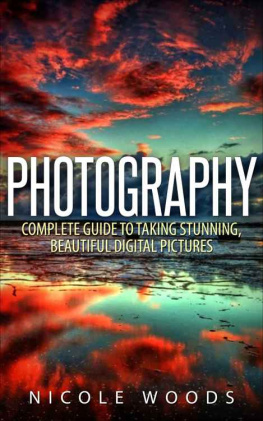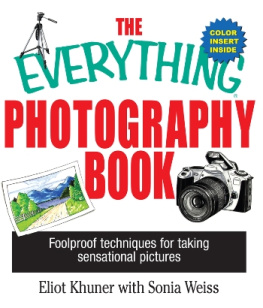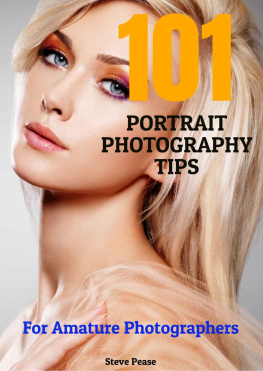Photography: Complete
Guide to Taking
 Image: Creative Commons
Image: Creative Commons
Stunning, Beautiful Digital Pictures
Copyright 2014 - All rights reserved.
In no way is it legal to reproduce, duplicate, or transmit any part of this document in either electronic means or in printed format. Recording of this publication is strictly prohibited and any storage of this document is not allowed unless with written permission from the publisher. All rights reserved.
The information provided herein is stated to be truthful and consistent, in that any liability, in terms of inattention or otherwise, by any usage or abuse of any policies, processes, or directions contained within is the solitary and utter responsibility of the recipient reader. Under no circumstances will any legal responsibility or blame be held against the publisher for any reparation, damages, or monetary loss due to the information herein, either directly or indirectly.
Respective authors own all copyrights not held by the publisher.
Legal Notice:
This ebook is copyright protected. This is only for personal use. You cannot amend, distribute, sell, use, quote or paraphrase any part or the content within this ebook without the consent of the author or copyright owner. Legal action will be pursued if this is breached.
Disclaimer Notice:
Please note the information contained within this document is for educational and entertainment purposes only. Every attempt has been made to provide accurate, up to date and reliable complete information. No warranties of any kind are expressed or implied. Readers acknowledge that the author is not engaging in the rendering of legal, financial, medical or professional advice.
By reading this document, the reader agrees that under no circumstances are we responsible for any losses, direct or indirect, which are incurred as a result of the use of information contained within this document, including, but not limited to, errors, omissions, or inaccuracies.
Table of Contents
Chapter 1: Finding Your Way Around The Camera
Chapter 2: Making Your Photographs Into Compositions
Chapter 3: Improving Your Nature and Landscape Photos
Chapter 4: Improving Your Portrait Photography
Chapter 5: Why Software Edits of Photos May Be a Mistake
Chapter 6: Capturing The Beauty of Moment
Chapter 7: What To Remember When Printing
Introduction
This book has been written because so many people buy digital cameras and never get further than using automatic settings. It's a real shame and although cameras are calibrated to take acceptable images using this feature, the scope of real photography goes a long way further than that.
The guide would make the perfect companion to that digital camera purchase so that those who receive the camera get the most out of it. Similarly, those who have simply just started to get interested in digital cameras can gain from this book because it's not written in a complex way that people can't understand. It's written by someone who was sitting exactly where you are now, but who learned to appreciate the intricacies of digital cameras and now shoots wonderful photographs because of letting the camera work to its maximum.
It's merely a question of getting your head around all the strange settings and it really isn't as frightening as it seems. This guide will help those who are hopelessly lost in understanding digital photography to produce stunningly beautiful digital images without too much effort at all. Every chapter is filled to brimming with information that will help the budding photographer become a very good photographer indeed, learning what the different settings on the camera mean and how to use them to advantage.
Follow through the explanations and you really will be able to produce pictures that astound your friends, but that most of all enthuse you in the art of photography. It is a very individual thing and what looks great to one photographer counts because it is the eye of the photographer and the ability to compose a picture gets coupled with an understanding of what the camera can do.
Your camera could earn you money. There are websites which offer photographers a real opportunity to get their names known online. There are also hobby websites for those who are more modest about their successes. However, once you understand the intricacies of using your digital camera, you will be proud to share your achievements.
Chapter 1 Finding Your Way Around the Camera
One of the first things that uninitiated photographers will be looking for when buying a camera is the number of pixels that the camera uses on an image. These are little dots that make up an image and theoretically the more you have available, the better the quality of the image. However, this isn't where it all starts or ends. Let's try and explain the way around your camera, so that you gain a better understanding.

Before doing that, you need to decide the kind of photographs that you are likely to take, as this will determine the kind of camera that you buy. For example, will you be taking distance shots of nature or sports? If so, you will need a camera with a telephoto lens. Will you want to use a macro or close up lens? Is there one available for the camera you are looking at. It isn't just about pixels. It's about the features that a camera has in relation to your use of that camera.
The key in owning your camera is in understanding its parts and how they work in relation to the kind of photos that you want to produce. In this section, you will learn about the most important parts of the digital camera and what roles they play in capturing beautiful moments.
Don t worry, this discussion will not get too technical, but will include just a few bits and pieces that will help you understand how your camera works and find your way around the different features.
1. The Body - The body encases the entirety of your camera. While it does not affect the quality of your photo, it plays a huge role in comfort and confidence while you are taking pictures. When buying a camera, look to see if the body looks solidly made because some are very cheap packages that are intended more for the child market. The body should be of a sturdy build and it's worthwhile holding it in your hands to see where the buttons are in relation to your fingers. Some are a little awkward to use, so choose a camera which fits your hand and which has a solid body and a great manufacturer's guarantee.
2. The Lens - The lens is perhaps one of the most important parts of your camera when you are concerned about the quality of photos. The photographic process begins here once the light enters the camera. Some cameras have a fixed lens, meaning you cannot change it. Others have interchangeable lens-- and this feature allows you to switch from one lens to another depending on your need. These are particularly useful for professional work or for specialty work such as nature pictures, sports images etc. You also have through the lens or TTL cameras, SLR or single lens reflex and of course, optical zoom lenses, meaning that the lens is built in but that it extends to form a longer lens for close-up work.
Since the discussion about focal points can be too technical, we will just discuss the different kinds of lens and how they affect the photos you will capture.
a. Ultra-wide angle - As the name suggests this lens can be used even when you are near the target of your photo, but even though you are very close to the subject, the whole frame will still be covered by it. This is useful for taking pictures of large crowds so is ideal for the wedding photographer or those who wish to produce images that incorporate a lot of detail over a wide space.










 Image: Creative Commons
Image: Creative Commons